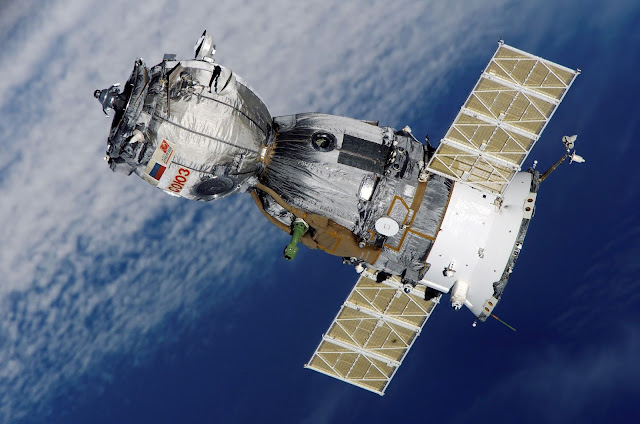Satellite Concept
- Satellite communication is based on a line-of-sight (LOS) one-way or two-way radio
frequency (RF) transmission system that comprises a transmitting station utilizing an
uplink channel, a space-borne satellite system acting as a signal regeneration node,
and one or more receiving stations monitoring a downlink channel to receive information. In a two-way case, both endpoint stations have the transmitting and the receiving
functionality (see Figure 1.1).
Satellites can reside in a number of near-earth orbits. The geostationary orbit
(GSO) is a concentric circular orbit in the plane of the earth’s equator at 35,786 km
(22,236 miles) of altitude from the earth’s surface (42,164 km from the earth’s
center – the earth’s radius being 6,378 km). A geosynchronous (GEO) satellite1circles the earth in the GSO at the earth’s rotational speed and in the same direction
as the rotation. When the satellite is in this equatorial plane it effectively appears to
be permanently stationary when observed at the earth’s surface, so that an antenna
pointed to it will not require tracking or (major) positional adjustments at periodic
intervals of time.2,3 Other orbits are possible, such as the medium Earth orbit (MEO)
and the low Earth orbit (LEO). - Communication satellites are microwave relay stations in outer space. A space shuttle launches satellite and places it in outer space precisely 36,000 kms above the equator with an orbit speed that matches earth's rotation speed exactly. Being in geosynchronous orbit, a satellite is stationary relative to the earth, and always stays over the same point on the ground. This allows a ground station to aim its antenna at a fixed point in the sky. Each satellite can receive and retransmit signals to slightly less than half the earth's surface because the earth is round. Therefore, to provide data transmissions needs. The positions of INSAT series of Indian satellites in outer space are such that they enable communication between any two locations in India.
- A communications satellite is a microwave repeater station that permits two or
more users with appropriate earth stations to deliver or exchange information in
various forms. As discussed later in this chapter and again in Chapter 6, a satellite
in a geostationary Earth orbit (GEO) revolves around the Earth in the plane of
the equator once in 24 hours, maintaining precise synchronization with the Earth’s
rotation. There are two other classes of 24-hour orbits: the geosynchronous orbit
and the highly elliptical synchronous orbit. - In the context of spaceflight, a satellite is an object that has been intentionally placed into orbit. These objects are called artificial satellites to distinguish them from natural satellites such as Earth's Moon. On 4 October 1957 the Soviet Union launched the world's first artificial satellite, Sputnik 1. Wikipedia
5. Advantages of satellite:
- A satellite having many transponders has enormous data communication capability.
- Data transmission costs are independent of distance between two points as long as these two points are withing the satellite's area coverage.
- As they support wireless communication, they do not require laying of cables and associated cost of land digging.
- A satellite is essentially a microwave relay station visible from any point in a very large area. Hence, it enables data transmission between any two randomly chosen points in that area.
6. Different Types of satellites around earth
- Phone communication satellites
- "Global Positioning System." (GPS) satellites
- weather information satellites
- Television (TV) Network channel satellites
7. Example of a satellite
8. Satellite networks, on the other hand, are well within the reach of much smaller
organizations because satellite capacity can be rented from a much larger company
or agency. Approximately half of the current commercial GEO satellites are owned
and operated by a few major companies that make the investment and sell the
service to regional and global markets. As the original global operator and now
the largest provider, Intelsat is able to serve users in nearly every country. Other
large operators include SES, Eutelsat, Loral Skynet, Telesat, and JSAT.
organizations because satellite capacity can be rented from a much larger company
or agency. Approximately half of the current commercial GEO satellites are owned
and operated by a few major companies that make the investment and sell the
service to regional and global markets. As the original global operator and now
the largest provider, Intelsat is able to serve users in nearly every country. Other
large operators include SES, Eutelsat, Loral Skynet, Telesat, and JSAT.
9. Satellite communicate image:
10. Satellite Antenna:
11. To enable a large number of users to benefit from satellite communication, communication service providers realized that they need to reduce the size and cost of receive-transmit earth stations considerably, so that a user can install a private earth station easily. To meet this requirement, they built smaller dish antennas, having lower power transmitters and receivers, for installation at user's sites. These dish antenna systems, are known as VSATs (Very Small Aperture Terminal).
Aperture refers to the diameter of dish antenna (about 1 to 2 meters.
I Hope you like this article Thanks for read this article.
Please share this article to your friends and family members..
subscribe to our blog for more articles...











1 Comments
ReplyDeleteشركة تنظيف موكيت بتبوك
شركة نظافة بتبوك
شركة نظافة منازل
نظافة عامة
شركات نظافة منازل
شركات تنظيف السيراميك بتبوك
شركات التنظيف بتبوك
For More Information Please Comment